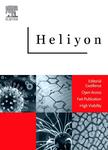版权所有:内蒙古大学图书馆 技术提供:维普资讯• 智图
内蒙古自治区呼和浩特市赛罕区大学西街235号 邮编: 010021

作者机构:Department of Civil Engineering Sharda School of Engineering and Technology Sharda University Greater Noida 201310 India Clean India Environment Pvt Ltd Haryana Gurgaon 122018 India Department of Mechanical Engineering Maulana Azad National Institute of Technology Bhopal 462003 India Department of Civil and Environmental Engineering Carleton University Ottawa Canada UTE University Faculty of Architecture and Urbanism Architecture Department TCEMC Investigation Group Calle Rumipamba S/N and Bourgeois Quito Ecuador Department of Biomaterials Saveetha Dental College and Hospital Saveetha Institute of Medical and Technical Sciences Chennai 600077 India The KU-KIST Graduate School of Energy and Environment Korea University 145 Anam-Ro Seoul Seongbuk-Gu 02841 South Korea Interdisciplinary Research Center for Construction and Building Materials Research Institute King Fahd University of Petroleum & Minerals Dhahran 31261 Saudi Arabia
出 版 物:《Heliyon》 (Heliyon)
年 卷 期:2025年第11卷第1期
页 面:e41336页
主 题:Environmental impact Industrial application Municipal solid waste Refuse-derived fuel Sustainable energy Waste management
摘 要:Urbanization and population growth in India have quickened, leading to an annual generation of around 62 million tonnes of municipal solid waste (MSW). Improper management of organic waste presents a major environmental problem due to air and water pollution, soil contamination and greenhouse gas production. This research aims to develop refuse-derived fuel (RDF) as a viable option, converting waste into a high-calorific energy carrier for industrial use. The RDF samples were collected from five strategic locations in Uttar Pradesh: Morta Site, Pipeline Site, and Sector 146 Noida, covering various waste compositions found at these landfill sites. Proximate and ultimate analyses of the RDF prepared from these sources were conducted, followed by in-depth Thermogravimetric Analysis (TGA) to validate its suitability as a potential feedstock. Careful waste segregation and treatment for better fuel quality can help minimize the difference in calorific values between different sites. Based on RDF tests, the waste-to-energy technology can divert over 30 % of solid waste from landfills and cut greenhouse gas emissions by as much as 25 % compared to traditional disposal methods. Unlike RDF, which is part of the replacement line for coal in industrial furnaces such as thermal power plants, it eliminates over 15 % and 20 % of sulfur dioxide (SO2) and nitrogen oxides (NOx). Ensuring that RDFs support sustainable energy technologies and align with circular economy principles, the study s results could enhance energy efficiency in waste management and complement environmental policy goals across all states in India and worldwide. © 2024 The Authors